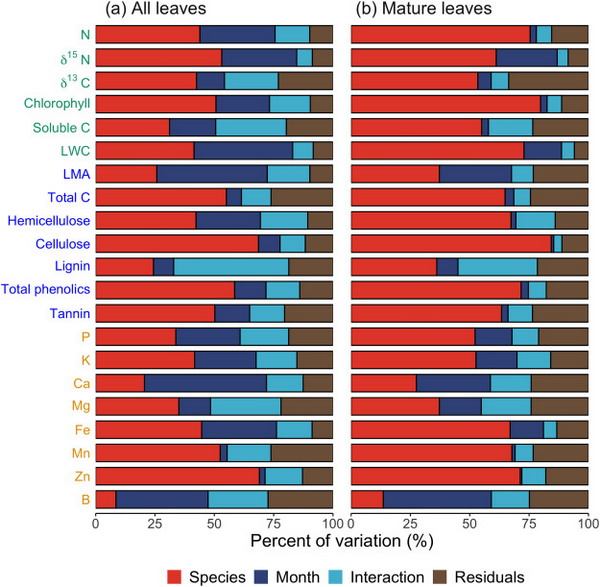Field spectroscopy is a powerful tool for monitoring leaf functional traits in situ, but it remains unclear whether universal statistical models can be developed to predict traits from spectral information, or whether re-calibration is necessary as conditions vary. In particular, multiple leaf traits vary simultaneously across growing seasons, and it is an open question whether these temporal changes can be predicted successfully from hyperspectral data. To explore this question, monthly changes in 21 physiochemical leaf traits and plant spectra were measured for eight deciduous tree species from the UK. Partial least-squares regression (PLSR) was used to evaluate whether each trait could be predicted from a single PLSR model from reflectance spectra, or whether species- and month-level models were needed. Physiochemical traits and spectra varied greatly over the growing season, although there was less variation among mature leaves harvested between June and September. Importantly, leaf spectroscopy was able to predict seasonal variations of most leaf traits accurately, with accuracies of prediction generally higher for mature leaves. However, for several traits, the PLSR estimation models varied among species, and a single PLSR model could not be used to make accurate species-level predictions. Our findings demonstrate that leaf spectra can successfully predict multiple functional foliar traits through the growing season, establishing one of the fundamentals for monitoring and mapping plant functional diversity in temperate forests from air- and spaceborne imaging spectroscopy.

Fig. 2. Partitioning of variance of leaf traits between species, month, species-month interaction and residual components for eight common tree species with 7 measurements between May and October (a, for all leaves), and with 4 measurements between June and September (b, only for non-senescent after mature leaves, here being abbreviated to mature leaves) at Madingley wood in Cambridge, UK across the growing season in 2017. Residual variation includes intraspecific variation among individual, microsite variability, canopy selection and measurement error variance. LMA, leaf mass per unit area (g m?2); LWC, leaf water content.
This result was published in Remote Sensing of Environme with the title of “Nitrogen addition, rather than altered precipitation, stimulates nitrous oxide emissions in an alpine steppe”.
The link below will guide you to the reading:
https://www.sciencedirect.com/science/article/pii/S0034425721004879
